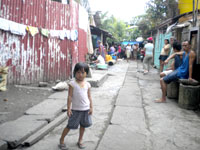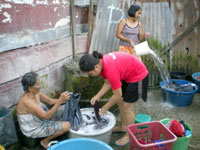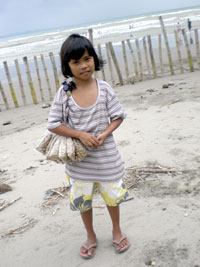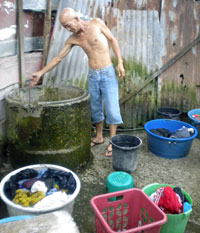We have to survive each other

A child stares oblivious to the adults
busily washing clothes in the “one for
all” well or those who are playing
“tong-its” behind her.
As of this writing, the world’s population is about 6.8 B.
In our country alone, primary statistical agency of the government National Statistics Office (NSO) projects that this year’s population will reach 92.23 M.
This means that the Philippine population will reach over 140 million by the year 2040 according to the final results from the 2000 census-based population projects.
As the world population grows, it is inevitable that WE HAVE TO SURVIVE EACH OTHER.
There is just no denying that the impact of a growing population is a universal problem.

Taking turns when there is only one well.
Why so? This is because according to a research presented during the American Association for the Advancement of Science, “as the world population continues to grow geometrically, great pressure is being placed on arable land, water, energy, and biological resources to provide an adequate supply of food while maintaining the integrity of our ecosystem. According to the World Bank and the United Nations, from 1 to 2 billion humans are now malnourished, indicating a combination of insufficient food, low incomes, and inadequate distribution of food. This is the largest number of hungry humans ever recorded in history. In China about 80 million are now malnourished and hungry. Based on current rates of increase, the world population is projected to double from roughly 6 billion to more than 12 billion in less than 50 years.”

A little girl happily holds some coins
from sale of boiled peanuts along
Villa Beach.
True, this may sound highfaluting but this is the reality. Each day, we count how many children will be born with a dim future because of lack of proper information that every woman has a choice.
Our women and even their husbands or partners can still do something by deciding to limit or space pregnancies. Access to voluntary family planning and reproductive health services are readily available in government agencies like Department of Health (DOH), Commission on Population (POPCOM), service health providers in barangays or municipalities and other partner non-governmental organizations (NGO’s).
A growing population has already become alarming but if population will continue to grow significantly, the effect will be devastating.
Imagine when every person is fighting for the most basic need according to Maslow’s hierarchy which is food. It already happened in China and other parts of the world.
In our country, the National Statistical Coordination Board (NSCB) reported in 2006 that 33 out of 100 Filipinos are poor. The severity of poverty in the Philippines needs no photos to show anybody.
“Res ipsa loquitor.” Indeed, one can just take a jeepney and see the shanties mushrooming near the rivers, creeks or just about anywhere. Malnourished children would play along the road like it was their playground.

An old man is not spared from fetching a
pail of water.
In some depressed communities, there is only one well where everybody can get water in order to bathe, drink and wash clothes. Worse, in this day and age of civilization, there are still rural and far-flung areas where they have to walk miles in order to get water.
Children have to stop studying or be told not to study at all because there is just not enough money to spend. Some are pushed by their own parents to work.
Four years ago in Brgy. San Jose, Arevalo, Iloilo City, the Educational Research and Development Assistance (ERDA) Foundation adopted some children who used to be child labourers to be their beneficiaries. This program by ERDA is commendable.
ERDA has over 19,000 beneficiaries enrolled in different levels of education all over the country. Its programs enlist school dropouts, child scavengers, street children, out of school youth, child laborers, children in conflict with the law, children of persons afflicted by leprosy and children of indigenous people. ERDA’s educational assistance programs are available from pre-school up to college. Since its inception, ERDA has come to the aid of over 600,000 indigent children all over the country.
ERDA gives free uniform and school supplies to their beneficiaries as well as miscellaneous fees for elementary and high school students who used to be children working in hazardous fireworks factory in Arevalo.
Barangay Health Woker (BHW) Anabelle Indencio and Barangay Nutrition Scholar (BNS) Noreen Abada share that there are many communities with malnourished children because of poor health practices in the areas of these affected children.
Indencio futher explains that the problem is the congestion and the over-crowdedness of the houses which makes it dangerous to public health especially to children.
Abada on the other hand expressed that there are only 9 malnourished children in Brgy. San Jose at the moment. This is because they closely monitor the children weighing them if they have the expected weight according to their age. But she said that it is also difficult to expect that because these children come from poor families and they do not get the proper nutrition from their food intake.
There is still time to act. Empowering our women that spacing and limiting pregnancies is a good choice is the first step if our women want to do their share.
